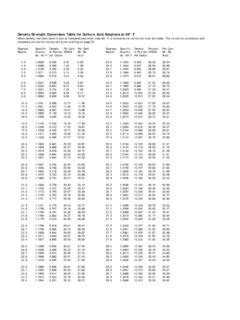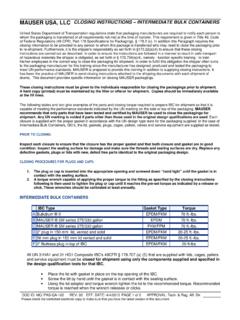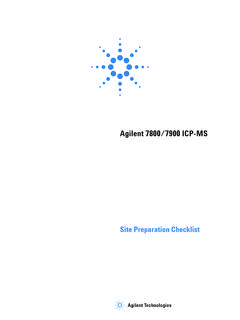Transcription of UNLOADING SULFURIC ACID - Southern States Chemical
1 26 Chemical Safety HandbookUNLOADING SULFURIC ACIDINTRODUCTIONThe following is a general guide to UNLOADING SULFURIC acid from tank cars and tank trucks. The primary intention of this section is to present typical procedures for UNLOADING SULFURIC acid by air pressure and pump. The information given is by no means complete, and actual UNLOADING conditions will necessitate the use of more detailed procedures to guarantee safe SULFURIC acid UNLOADING procedures and safety regulations can be found in the following industry and government publications:49 CFR 171-181 Code of Federal Regulations, Department of Transportation (DOT)29 CFR 1910 Code of Federal Regulations, Department of Labor (OSHA)The above applicable sections of the Federal Regulations should be reviewed prior to the installation of UNLOADING facilities or the drafting of detailed UNLOADING procedures for your site. Particular attention should be given to the following and other applicable sections of the Federal Regulations:CFR TITLE 49 DEPARTMENT OF Spill and Leak &.
2 510 Placards, Rail Placards, Cargo Tanks172, Subpart H Employee Training, Hazardous Empty Authorized containers, SULFURIC UNLOADING Tank UNLOADING Cargo Securing Closures, Highway179, Subpart C &D Containers Specification, Tank & .200-18 Safety Relief Devices, Tank Cars180, Subpart E Qualification and Maintenance of Cargo Tanks27 Chemical Safety HandbookCFR TITLE 29 DEPARTMENT OF (b) Stairs, Walkways, Work Emergency (c) Personal Protective Respiratory (c) Safety Showers, Eye Wash Hazard CommunicationSHIPPING INFORMATIONS ulfuric acid having a concentration greater than may be shipped in the following Department of Transportation (DOT) authorized tank cars and tank trucks:Tank Cars Tank Trucks103A-103AW-103CW MC-310105A300W MC-311111A60W2-111A100W2 MC-312111A100W6-111A100F2 The above is only a partial list of authorized containers.
3 Consult 49 CFR formore cars and tank trucks vary in design and piping arrangement, and require different UNLOADING procedures. For specific UNLOADING procedures, refer to information sources listed cars and tank trucks may be insulated, insulated and coiled (internal or external), for shipments of acid concentrations that will freeze at ambient temperatures. High quality acid is usually shipped in containers that are lined to reduce contamination from container corrosion during transit. Some authorized tank cars for shipment of heavy (sludge spent) acids are equipped with bottom outlets. The procedures for safely handling this type acid depend on too wide a quality range to be included in this Safety HandbookUNLOADING TANK CARS AND TANK TRUCKSS outhern States tank cars and tank trucks are shown in Figures 1 and 2. They are available in 100 ton tank cars, and approximately 24 ton tank following UNLOADING procedures are intended to familiarize the reader with the important steps and considerations necessary to safely unload a typical SULFURIC acid shipping container with air pressure or by pump.
4 No attempt is made here to show the specifi c procedures required for UNLOADING each of the various specifi cally authorized containers. If more detailed information is required, please contact your Safety HandbookGENERAL PRECAUTIONSP lease refer to the Safety Section of this Handbook for the proper protective clothing to use when making or disassembling connections of SULFURIC acid piping. When disassembling acid piping connections that are above head high, or that are expected to contain acid , a full cover acid hood is also by a qualified person during the entire UNLOADING procedure is required. This person must be thoroughly familiar with the hazards of SULFURIC acid , and all operating, emergency, safety and fi rst aid procedures recommended for its safe large supply of cold water should be available at the UNLOADING site for reasons of personal safety, as described in the Safety Section, and to wash down any acid that may be remote backup safety shower is recommended, along with a signal system designed to get assistance if an emergency should arise.
5 The signal system and safety showers should be tested routinely. Signs restricting access to the area during UNLOADING should be should be arranged to allow draining by the use of vent and drain valves. Connections should be made below waist high. Trapping acid between valves should be avoided. Storage tanks must be adequately vented to avoid pressure build up during UNLOADING . Overflow piping should be directed to a harmless UNLOADING site should be designed to provide good ventilation, lighting, and OSHA-approved access to all connection points. Non-sparking tools should be used when working around SULFURIC acid piping and containers, since hydrogen gas can be produced by corrosion. Open fl ame, smoking, and other ignition sources must not be allowed in the UNLOADING exposure to vapors and acid mist when handling SULFURIC acid or oleum. Pump UNLOADING with a vapor recovery system is recommended for equipment should be available in the event of spills or other fume Figures 3 and 4 showing a typical air supply and shipping container confi 3.
6 Air piping arrangement for UNLOADING acid tank Safety HandbookTYPICAL UNLOADING PROCEDURE USING AIR PRESSURE FOR EDUCTION TUBE TOP UNLOADING Verify the contents of the container by checking the shipping papers and container stenciling and/or placarding. Make sure the receiving storage tank has sufficient outage to hold the contents of the container being unloaded. Inspect the shipping container for leaks or damage which could interfere with safe UNLOADING . Set the brakes and block the wheels of the shipping container . For rail cars, install the required warning Carefully open the air connection valve and vent any pressure in the container . If no venting occurs, check to make certain the air connection and valve are unobstructed. Carefully loosen the fill hole cover bolt (do not disengage), and pry up slightly. If any pressure is present, let it bleed off slowly until no pressure is in the tank, then open the fill hole cover.
7 Samples may be taken at this : All pressure must be vented before any container fittings are removed because of the danger of acid spray. Do not remove the cap from the liquid eduction pipe until it is definitely known that all pressure has been vented from the container , and that the valve is closed (if so equipped).3. Close the liquid eduction valve (if so equipped), and carefully remove the cap from the valve, or from the liquid eduction pipe (if no valve is provided). Inspect the condition of the threads, gaskets and liquid eduction pipe carefully. Pipe threads in SULFURIC acid service deteriorate rapidly, especially when exposed to acid and atmospheric moisture. Make a two inch or larger steel pipe connection to the line leading to the acid storage tank. Swivel connections are available which can be used to facilitate such connections. Flexibility can also be provided by the use of an armored hose approved for SULFURIC acid or oleum use.
8 A valve located as close as possible to the liquid eduction pipe is an excellent safety item. If quick couplings are used, the cams or ears should be tied and locked in their closed Connect the air line to the air connection valve. The air supply must have a check valve; a pressure reducing valve set at about 28 pounds per square inch gauge pressure; and a safety relief valve set at not over 30 pounds per square inch guage pressure. A pressure gauge and bleed valve are also required to insure proper pressure is maintained, and to bleed off the Figure 4. Tank car dome with air inlet and liquid eduction Safety Vent B. Eduction Pipe C. Air Pipe D. Fill-Hole CoverThis configuration requires the installation of anair pipe and valve between the safety vent and the car31 Chemical Safety Handbookpressure when the container is empty. The air should be non-contaminated, free from oil, moisture and foreign matter. A suitable inert gas may be substituted for the UNLOADING air if the fill hole cover and inspect the system to be sure that it is tight, that all vent and bleed valves on the UNLOADING line are closed, and that all valves are properly positioned to receive Slowly apply air pressure to the container by opening a valve on the air supply line located outside of the probable spray area, being careful not to exceed 28 pounds per square inch guage pressure.
9 If the air pressure is to high, the safety relief valve on the supply line will open. If pressure cannot be maintained, check for leaks or a broken frangible disc. Do not replace the frangible disc with other than an authorized, properly rated leaks develop or acid is spilled, promptly wash down any surface where acid has spilled with an excess of water, being extremely careful to avoid getting water into the container , piping or into large accumulations of acid in holes or trenches. If the valving is properly set, acid will flow to the storage tank. If flow cannot be established or maintained, the use of an UNLOADING pump may be the container is empty, a drop in the pressure and the sound of air rushing through the discharge pipe will be heard. Shut off the air supply, then shut off the valve in the UNLOADING line near the connection point. Allowing some air to flow through the UNLOADING line will help clear the acid from the Vent all pressure from the shipping container through the air supply line bleed valve.
10 Carefully open the fill hole cover, and inspect the container to insure UNLOADING is complete. Disconnect the air supply line. When the UNLOADING line has been completely drained, carefully disconnect it (highest point first) from the shipping container . If the UNLOADING line is not equipped with a drain and vent valve, acid should be expected to spill out at the disconnect Close the fill hole cover tightly and replace the caps on the air connection valve and liquid eduction line. Replace the valve covers. Inspect the container and place proper DOT required placards on the container for the return UNLOADING PROCEDURE USING Use the same preparation and procedural Steps 1 through 3 listed on page 43 for UNLOADING by air pressure apply to UNLOADING by A self-priming pump is recommended. Vent the container to the atmo-sphere by leaving the fill hole cover open. Start the pump from outside the probable spray area.





